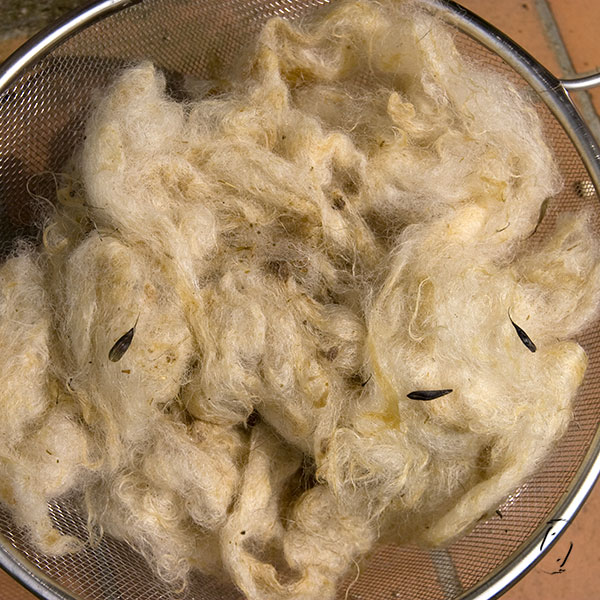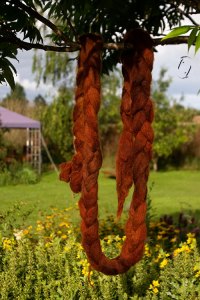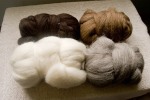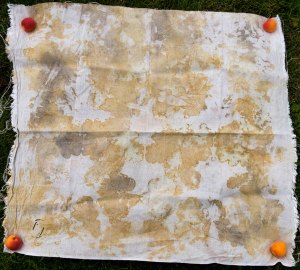Summer being what it is this year (sweater weather – ooops, I said it again) and my plastic greenhouse falling apart from exposure (let’s just say I don’t need to air it out when it’s sunny OR water my plants, that all happens naturally), I’m going to see if our kitchen window gets hot enough for some solar dyeing experiments. A south window would be better, but the cats use those and they’re not very particular about what they shove out of the way. So east it is. Here’s a couple of pix of my preparations:
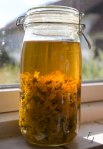
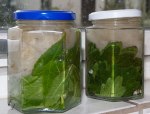
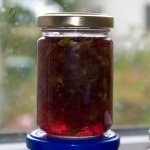
- Anthemis tinctoria getting ready for some mulberry silk top. Just poured some boiling water in and left it for a few days.
- A couple of small cotton placemat thingies? that I scoured and wadded up with oak leaves in one jar, sumac leaves in the other, some of the famous Dorset on top. Mainly for the tannin, I expect to be overdyeing with something after. Possibly solar dyeing with the last coreopsis in the freezer.
- Hypericum in vodka – just for laughs. I can’t find enough to make a serious dyebath from these, I’ll have to get seeds next year.
- Some Suffolk fleece stuffed into leftover acid dye mixes. Let’s see if it will exhaust without steaming!
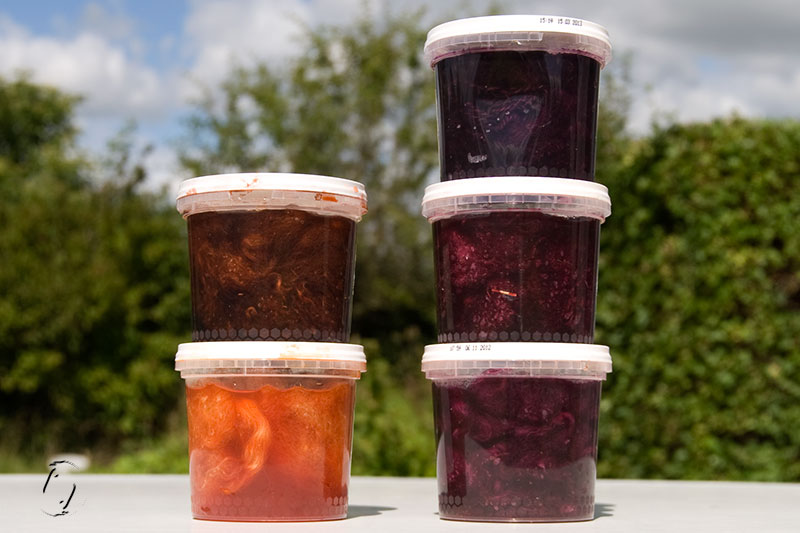
Last year I scraped off a teeny amount of lichen from some dead trees. Thinking it might be the parmawossname saxatilis? that yields blue which then sometimes turns to pink when exposed to sunlight. Soaked it in ammonia and it looked pretty brown for a long time until I forgot about it. It’s been sitting in the greenhouse all winter, until I found the bucket again yesterday. Inside was a clear blue liquid (much like that blue toilet water you see someplaces) and the plant matter just some black fluff at the bottom. In went some fleece and the day after it looked like this:
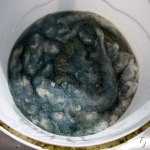
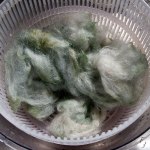
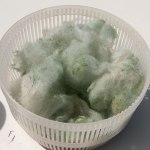
I have no idea if this is lichen dyed or ammonia dyed… It doesn’t turn pink in the sun anyway or change when soaked in vinegar.
I have further plans for cold dyeing:
- Privet berries and elderberries
- Alder cones (or are they actually catkins?)
- Perhaps madder?
- Anything interesting that I come upon that can be stuffed into a jar basically. Avocado pits or skins are candidates.
- Onion peels
I’ve been pondering whether the jars would get hotter and the colours preserved better in coloured jars. Which colour would work best I wonder, green, red, black? One could cover the glass jars in coloured cellophane, that would make it easy to check on the progress.
This is an excellent blog on the subject that someone posted on Ravelry.
Dre has had a lot of scientific thoughts on the subject
â Leave a Comment
Solfarvning 1
Min plan omkring solfarvning – dvs. koldt vand som sÃ¥ blot opvarmes via solen i xx dage eller uger istedet for at koge planter og uld – holder ikke helt stik pga vores meget kolde sommer OG fordi mit Lidl plastdrivhus er ved at falde fra hinanden, betrækket kan simpelthen ikke holde til vind og vejr, sÃ¥ alle de smÃ¥ “ruder” er ved at falde ud. Dvs. jeg ikke kan fÃ¥ temperaturen i mine farveglas op, pÃ¥ den anden side behøver jeg hverken luft ud derinde eller vande planter, det klarer naturen selv….
Men nu prøver jeg alligevel et par bøtter i køkkenvinduet, noget silke, noget Dorset, et par bomuldsblondepynteting proppet i vand med egeblade som en slags bejdsning, perikumn i vodka, fordi jeg ikke har fundet blomster nok til at farve en ordentlig mængde uld med, men noget skulle der ske. Og så et par bøtter med syrefarverester. Enten er varmen nok på sigt til at klare vandet = farven sidder på ulden, eller også damper jeg det til sidst hvis det ikke virker. På den måde regner jeg med efterhånden at få regnbuefarvet en del af den Suffolkham som jeg fik gratis hos min høleverandør.
De der 40 + grader man kan få i et drivhus kommer jeg nok ikke op på selvom sylteglassene måske nok i sig selv gør lidt. Det gule glas med gåseurt var i hvert fald håndlunt da jeg mærkede efter, men ikke så varmt at mit termometer kunne vise noget.









